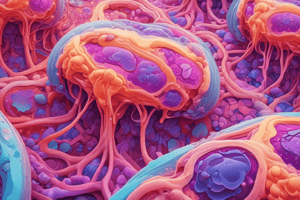Podcast
Questions and Answers
What is the mechanism of aminoglycoside nephrotoxicity?
What is the mechanism of aminoglycoside nephrotoxicity?
- Causes vasodilation of afferent arterioles
- Accumulates in the proximal tubules, causing oxidative stress (correct)
- Blocks sodium channels in distal tubules
- Inhibits protein synthesis in kidney cells
What is a clinical presentation of radiographic contrast media nephrotoxicity?
What is a clinical presentation of radiographic contrast media nephrotoxicity?
Non-oliguric AKI with SCr peaking 3-4 days after exposure
Cisplatin nephrotoxicity causes increased serum magnesium levels.
Cisplatin nephrotoxicity causes increased serum magnesium levels.
False (B)
What is a management strategy for amphotericin B nephrotoxicity?
What is a management strategy for amphotericin B nephrotoxicity?
Which drugs are involved in osmotic nephropathy?
Which drugs are involved in osmotic nephropathy?
What is the clinical presentation linked to ACE inhibitors and ARBs?
What is the clinical presentation linked to ACE inhibitors and ARBs?
NSAIDs inhibit ______ synthesis, which reduces afferent arteriolar dilation.
NSAIDs inhibit ______ synthesis, which reduces afferent arteriolar dilation.
Cyclosporine causes vasodilation of afferent arterioles.
Cyclosporine causes vasodilation of afferent arterioles.
What is the mnemonic for remembering the effects of SGLT-2 inhibitors?
What is the mnemonic for remembering the effects of SGLT-2 inhibitors?
What is the primary effect of CAR T-cell therapy on kidney function?
What is the primary effect of CAR T-cell therapy on kidney function?
Flashcards are hidden until you start studying
Study Notes
Acute Tubular Injury/Necrosis
- Aminoglycoside Nephrotoxicity:
- Accumulates in proximal tubules, causing oxidative stress and cellular necrosis.
- Enters through endocytosis due to its cationic nature, leading to tubular obstruction.
- Clinical Presentation: Gradual increase in serum creatinine (SCr), decreased urine output, seen 5-7 days after treatment.
- Diagnostics: Rising SCr and BUN, decreased creatinine clearance.
- Management: Discontinue therapy, use alternative antibiotics like penicillin.
- Radiographic Contrast Media Nephrotoxicity:
- Causes renal vasoconstriction via the release of adenosine and endothelin, leading to ischemia and reduced renal blood flow.
- Clinical Presentation: Non-oliguric AKI, with SCr peaking 3-4 days after exposure.
- Management: Avoid nephrotoxic agents, hydrate, use low-osmolar contrast.
- Cisplatin Nephrotoxicity:
- Accumulates in proximal tubular cells, causing oxidative damage and necrosis.
- Clinical Presentation: Polyuria, decreased serum magnesium, hypokalemia, and hypocalcemia.
- Management: Adjust doses, manage electrolyte disturbances.
- Amphotericin B Nephrotoxicity:
- Binds to ergosterol in the kidney’s cell membrane, causing increased permeability and necrosis.
- Induces vasoconstriction in afferent arterioles.
- Clinical Presentation: Nonoliguric AKI, electrolyte wasting.
- Management: Switch to liposomal Amphotericin, replace electrolytes.
Osmotic Nephropathy
- Drugs involved: Mannitol, intravenous immunoglobulin (IVIG) containing sucrose.
- Mechanism: High osmolar drugs cause cellular swelling and vacuolization in proximal tubular cells.
- Presentation: Oliguria 2-4 days after exposure; cellular swelling is evident.
- Management: Discontinue the offending agent.
Hemodynamically Mediated Kidney Injury
- ACEIs and ARBs:
- Dilate efferent arterioles, reducing glomerular pressure and thereby lowering glomerular filtration rate (GFR).
- Risk Factors: Patients with renal artery stenosis, CHF, or pre-existing kidney disease.
- Clinical Presentation: AKI with rise in serum creatinine.
- Management: Monitor SCr, discontinue if creatinine rises >30%. Initiate low dose.
- NSAIDs and COX-2 Inhibitors:
- Inhibit prostaglandin synthesis, reducing afferent arteriolar dilation, leading to ischemia in conditions of reduced renal blood flow.
- Clinical Presentation: AKI within 2-7 days, weight gain, diminished urine output, elevated BUN, SCr, and blood pressure.
- Management: Stop NSAIDs and provide supportive care. Kidney function typically recovers in 3-5 days.
- Cyclosporine & Tacrolimus:
- Causes vasoconstriction of afferent arterioles through increased thromboxane A2 and endothelin production, leading to reduced renal plasma flow and GFR.
- Clinical Presentation: Hypertension, hyperkalemia, decreased GFR.
- Management: Dose reduction, calcium channel blockers.
- SGLT-2 Inhibitors:
- Can cause volume depletion and reduce renal perfusion.
- Lead to prerenal AKI by reducing glomerular filtration through vasoconstriction of the afferent arteriole via tubuloglomerular feedback.
- Clinical Presentation: AKI, volume depletion, and prerenal azotemia.
- Diagnostics: Elevated serum creatinine and decreased GFR, urinalysis for dehydration markers.
- Management: Discontinue the drug, ensure hydration, treat electrolyte imbalances, provide IV fluids for volume depletion.
- Chimeric Antigen Receptor (CAR) T-Cell Therapy:
- Trigger a cytokine release syndrome, leading to acute kidney injury by causing endothelial damage.
- Clinical Presentation: AKI, tumor lysis syndrome.
- Management: Treat cytokine release syndrome with steroids, manage electrolyte abnormalities.
Studying That Suits You
Use AI to generate personalized quizzes and flashcards to suit your learning preferences.




